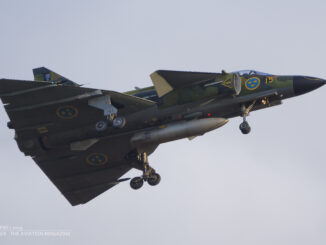 IAR 99 Șoim (s/n 7505305, ´709´ of the Romanian Air Force), flying display at Bucharest International Air Show 2012, Bucharest, July 2012.
IAR 99 Șoim (s/n 7505305, ´709´ of the Romanian Air Force), flying display at Bucharest International Air Show 2012, Bucharest, July 2012.
In the mid-1970s, Romanian aviation industry began development of a new advanced trainer and light attack aircraft – the first jet of that kind to be completely designed and built domestically. Majority of the works, including construction of three prototypes, were assigned to Avioane Craiova.
That manufacturer already had some experience with building light jet aeroplanes. At the beginning of 1970s, Avioane Craiova – in cooperation with SOKO in Yugoslavia – developed a subsonic close air support and reconnaissance jet, IAR-93 Vultur. From the late 1970s, as a part of national consortium, the company was involved in IAR-95 programme that was a Romanian attempt to create its own jet fighter aircraft.
Although the IAR-95 development was cancelled within a few years, due to lack of funds, the abovementioned IAR-93 entered operational service with the Romanian Air Force and was built in almost 90 examples. Furthermore, the IAR-99 had better luck and its development was continued, despite the political and economic issues of the mid-1980s.
On 21st December 1985, the first prototype of the IAR-99 performed its maiden flight, flown by Lt. Col. Vagner Ștefănel. After further evaluation of two further prototypes, the aircraft was approved for serial production and officially named Șoim (English: Hawk). In 1987, serial manufacturing of the new Romanian trainer had begun.
The IAR-99 is a two-seat subsonic training and close air support jet. The aircraft is powered by a single jet engine – licence-built Romanian variant of Viper Mk.632. Its armament includes one 23mm GSh-23L autocannon and a variety of missiles and bombs that can be attached to four underwings and one central hardpoints.
Although the aircraft is known of its excellent aerodynamic qualities and flight characteristics, avionics suite always was its Achilles´ heel. Developed and manufactured during the times of crisis, the IAR-99 was initially equipped with outdated avionics, incomparably worse that of Western aeroplanes of the same role and configuration.
Therefore, it was no surprising that, starting from the early 1990s, the Avioane Craiova company made several attempts to upgrade the IAR-99 avionics, partially aiming for opportunity of international sales of that aircraft. Within these modernization programmes, Honeywell and Collins avionics suites were installed in a few chosen aircraft that later were presented at international aviation events, as well as proposed for the Joint Primary Aircraft Training System for the USAF and US Navy.
Regrettably, none of the aforementioned attempts was successful and no orders from abroad were received.
In 1996, the first upgrade programme for the IAR-99 aircraft was launched. It was performed by Elbit company from Israel, the same that earlier already upgraded the Romanian MiG-21 LanceR fighters. An integration with the MiG-21 was one of the objectives of the modernization, allowing the IAR-99 to become a training platform for the upgraded LanceRs.
Although initial contract assumed that all IAR-99 jets in operational service would be the subject of the abovementioned modernization, the order was shortly reduced to twelve aircraft. The upgrade was performed between 2003 and 2008, and the modernized aeroplanes received designation IAR-99 C.
In December of 2015, Romanian press informed about new version of the aircraft being currently developed by Avioane Craiova and designated IAR-99 TD. The aeroplane was then expected to be completed in three or four years. Nevertheless, the last press release about that version was issued in the middle of 2019 and informed that the IAR-99 TD is still under development.
Nevertheless, the Romanian Air Force once again re-opened the issue of the IAR-99 modernization. On 14th December 2020, the Elbit company officially announced it was awarded a contract worth 27 million USD for upgrading the entire fleet of IAR-99 aircraft. According to the company, the standard version of the aeroplane was going to receive advanced avionics, live training Embedded Virtual Avionics system as well as close air support and air-to-air capabilities. That upgrade was focused on allowing the Romanian Air Force pilots an effective transition to the operation of advanced fighter aircraft.
Despite its advantages, the IAR-99 was manufactured solely for the Romanian Air Force that remains its only operator. There were twenty-eight aircraft of that type built, including three prototypes. Nineteen of the IAR-99 aeroplanes are still being operated by the Romanian Air Force, seven were lost in accidents.



